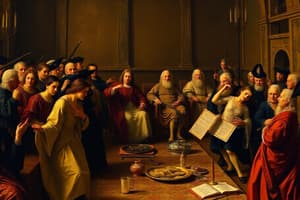Podcast
Questions and Answers
What was the primary reason for Charles I's conflict with Parliament?
What was the primary reason for Charles I's conflict with Parliament?
- His attempts to form alliances with Scotland
- The lack of military support from France
- His heavy taxation on the nobility
- Political tensions over governance and authority (correct)
Which battle was the first major confrontation of the First Civil War?
Which battle was the first major confrontation of the First Civil War?
- Battle of Marston Moor
- Battle of Edgehill (correct)
- Battle of Preston
- Battle of Naseby
What major political shift occurred after Charles I's execution?
What major political shift occurred after Charles I's execution?
- Restoration of the monarchy under Charles II
- Establishment of the Commonwealth (correct)
- End of Parliamentary sovereignty
- Formation of a constitutional monarchy
Which battle marked a decisive victory for Parliament during the First Civil War?
Which battle marked a decisive victory for Parliament during the First Civil War?
What role did Oliver Cromwell play during the Civil Wars?
What role did Oliver Cromwell play during the Civil Wars?
What characterized Cromwell’s rule during the Protectorate?
What characterized Cromwell’s rule during the Protectorate?
What was a significant outcome of the Second Civil War?
What was a significant outcome of the Second Civil War?
How did the Restoration of the monarchy in 1660 affect the powers of Charles II?
How did the Restoration of the monarchy in 1660 affect the powers of Charles II?
Match the themes of ambition with their descriptions:
Match the themes of ambition with their descriptions:
Match the characteristics of Faustus with their corresponding descriptions:
Match the characteristics of Faustus with their corresponding descriptions:
Match the elements of the tragic hero with their definitions:
Match the elements of the tragic hero with their definitions:
Match the religious themes presented in Faust with their implications:
Match the religious themes presented in Faust with their implications:
Match the aspects of the Faustian bargain with their characteristics:
Match the aspects of the Faustian bargain with their characteristics:
Match the consequences of Faustus’s ambition with their results:
Match the consequences of Faustus’s ambition with their results:
Match the elements related to Faustus’s character with their implications:
Match the elements related to Faustus’s character with their implications:
Match the thematic moral lessons of Faust with their lessons:
Match the thematic moral lessons of Faust with their lessons:
Match the tragic elements of Faustus’s story with their descriptions:
Match the tragic elements of Faustus’s story with their descriptions:
Match the components of ambition in Faustus with their representations:
Match the components of ambition in Faustus with their representations:
Flashcards are hidden until you start studying
Study Notes
Causes Of The Conflict
- Political Tensions: Struggle between Parliament and King Charles I over governance and authority.
- Religious Disputes: Conflicts between Anglicans and Puritans, with Charles favoring the former.
- Financial Issues: Charles' attempts to raise taxes without Parliament’s consent led to resentment.
- Personal Rule: Charles I's decision to rule without Parliament from 1629 to 1640 increased tensions.
- Scottish Rebellion: The Bishops' Wars against Scotland in 1639-1640 drained resources and necessitated calling Parliament.
Key Battles And Events
- First Civil War (1642-1646):
- Battle of Edgehill (1642): First major battle; inconclusive outcome.
- Battle of Marston Moor (1644): Significant Parliamentarian victory; control of North England.
- Battle of Naseby (1645): Decisive Parliamentarian victory; weakened royalist forces.
- Second Civil War (1648):
- Battle of Preston (1648): Final defeat of royalist forces; led to Charles I's trial.
- Trial and Execution of Charles I (1649): Marked a pivotal moment in rejecting monarchical rule.
Political Implications
- Establishment of the Commonwealth: Following Charles I's execution, England became a republic under Oliver Cromwell.
- Rise of Parliamentary Sovereignty: Shifted the balance of power towards Parliament; questioned the divine right of kings.
- Cromwell’s Protectorate (1653-1658): Established a military dictatorship; significant control over politics.
- Restoration of the Monarchy (1660): Charles II ascended, leading to a re-establishment of the monarchy but with limited powers.
Major Figures
- Charles I: King whose conflicts with Parliament sparked the war; executed in 1649.
- Oliver Cromwell: Leading figure on the Parliamentarian side; became Lord Protector.
- King Charles II: Son of Charles I; restored to the throne after the Commonwealth period.
- Thomas Fairfax: Commander of the New Model Army; key military leader for Parliament.
- John Pym: Prominent Parliamentarian politician; played a major role in early conflict.
Aftermath And Legacy
- Political Changes: Established precedent for parliamentary power and constitutional monarchy.
- Social Impact: War influenced class structures and societal roles; Puritan values became more prominent.
- Cultural Legacy: Inspired literature, political thought, and future revolutionary movements (e.g., American Revolution).
- Long-term Ramifications: Led to debates on governance, rights, and the role of monarchy that lasted for centuries.
Causes of the Conflict
- Political struggle between Parliament and King Charles I over authority and governance led to heightened tensions.
- Religious tensions arose from the conflict between Anglicans, favored by Charles I, and Puritans, contributing to instability.
- Charles I's efforts to impose taxes without Parliament's approval fostered resentment among the populace.
- The period from 1629 to 1640, where Charles ruled without Parliament, intensified the existing conflicts.
- The Bishops' Wars (1639-1640) against Scotland drained resources and forced Charles to call Parliament for support.
Key Battles and Events
- The First Civil War (1642-1646) began with the inconclusive Battle of Edgehill, the war's first major confrontation.
- The Battle of Marston Moor (1644) marked a crucial Parliamentarian victory, resulting in control over Northern England.
- A decisive victory at the Battle of Naseby (1645) effectively weakened royalist forces.
- The Second Civil War culminated in the Battle of Preston (1648), leading to the final defeat of royalist troops and paving the way for Charles I's trial.
- The trial and execution of Charles I in 1649 represented a critical turning point, symbolizing a rejection of absolute monarchy.
Political Implications
- The Commonwealth was established after Charles I's execution, transitioning England into a republic under Oliver Cromwell.
- This period marked a significant shift towards parliamentary sovereignty, challenging the traditional notion of the divine right of kings.
- Cromwell's Protectorate (1653-1658) instituted a military dictatorship, exerting substantial control over the state.
- The monarchy was restored in 1660 with Charles II, but constitutional limitations were placed on royal powers.
Major Figures
- Charles I was the king whose disputes with Parliament triggered the Civil War; he was executed in 1649.
- Oliver Cromwell emerged as a prominent leader for the Parliamentarians and later served as Lord Protector.
- King Charles II, the son of Charles I, returned to power following the end of the Commonwealth period.
- Thomas Fairfax served as the commander of the New Model Army and was a pivotal military leader for Parliament.
- John Pym, a significant Parliamentarian figure, was influential during the early stages of conflict.
Aftermath and Legacy
- The conflict established a precedent for parliamentary power, influencing the development of constitutional monarchy in England.
- Social dynamics shifted as the war impacted class structures; Puritan values became more entrenched in society.
- The legacy of the war resonated through literature and political thought, influencing future revolutionary movements, including the American Revolution.
- Long-lasting discussions emerged around governance, civil rights, and the role of the monarchy, shaping political discourse for centuries to come.
Themes of Ambition
- Excessive ambition drives Faustus, a Renaissance archetype, to seek knowledge and power beyond human limits.
- His desire for power leads him to make a pact with Lucifer, showcasing a prioritization of self-interest over ethical considerations.
- The tragic outcome of Faustus’s ambition culminates in his damnation, serving as a warning against the dangers of overreaching.
Character Analysis of Faustus
- Faustus is portrayed as a complex protagonist, balancing brilliance as a scholar with tragic flaws shaped by conflicting desires.
- His hubris manifests in the belief that he can manipulate hell’s powers and control Mephistopheles.
- Moments of regret and despair surface, particularly towards his demise, highlighting his inherent humanity amidst the pursuit of power.
- As a symbol of the Renaissance spirit, Faustus embodies the quest for knowledge but also warns of the dire consequences of unchecked ambition.
The Tragic Hero
- Faustus exemplifies a classic tragic hero, with his excessive pride ultimately leading to his downfall and demise.
- His tragic fate elicits pity and fear, illustrating the disastrous repercussions of his misguided choices.
- The struggle for redemption is evident, yet Faustus's inability to repent solidifies his irreversible failure.
Religion and Morality
- The narrative explores the conflict between Renaissance humanism and the moral frameworks of medieval Christianity.
- Faustus’s eternal damnation provokes critical questions regarding divine justice and the nature of mercy.
- The story emphasizes the moral ramifications of prioritizing knowledge and power over faith and humility.
Faustian Bargain
- Faustus engages in a Faustian bargain, trading his soul for 24 years of knowledge and magical abilities, epitomizing this mythic archetype.
- Initially, Faustus is under the illusion that he can control the powers granted to him, but he soon finds himself enslaved by his own ambitions.
- The bargain underscores a critical theme: the pursuit of knowledge and power can exact a severe moral toll.
Studying That Suits You
Use AI to generate personalized quizzes and flashcards to suit your learning preferences.




